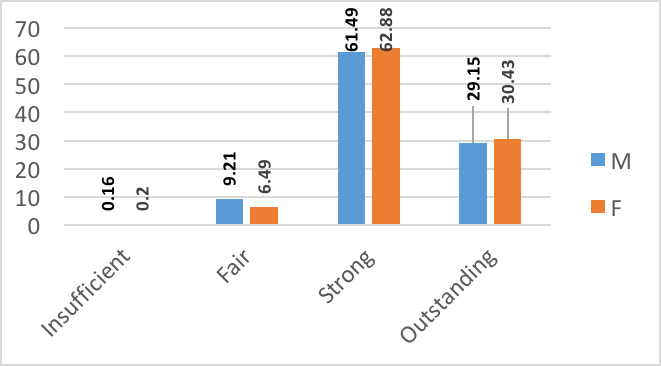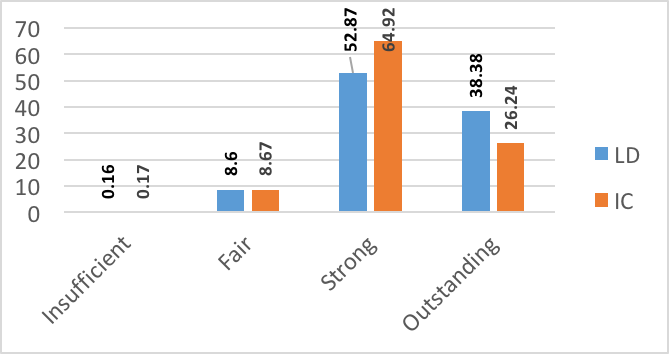The new MERIT scheme was introduced in 2016, following the recommendation of the five-yearly review. It has been developed as a lighter performance appraisal process, with four performance qualifications: insufficient, fair, strong and outstanding. The suggested CERN-wide distribution of these qualifications is 6-12% fair, 57-63% strong and 27-33% outstanding and HR are pleased to report that this distribution has been met for 2017 (9%, 62% and 29%). HR has analysed the distribution across several axes and some of the results (by contract type and gender) can be found below.
- Distribution by gender

We were pleased to observe no gender bias in this exercise, and the results for men and women are very close. The overall ratio of men to women at CERN is 80:20 (more information on CERN’s overall demographics may be found in the CERN Personnel Statistics at this link, which were presented to the TREF delegates in May).
- Distribution by contract type

Concerning the distribution by contract type we see that the total percentage of outstanding and strong between staff members with LD and IC contracts is almost identical. There is however a higher proportion of ‘outstanding’ among the LD population, which is consistent with previous observations under the MARS, MAPS and MOAS systems.
Better cartography of our staff
The introduction and initial mapping of Benchmark Jobs (BMJ) has produced a more accurate picture of the Organization and HR has analysed more than 400 requests to change BMJ, the majority from supervisors and relating to a BMJ in the same grade span. As a result, our personnel database is now more up to date and will better reflect reality when we next report to our Member States.
Change of grade (promotions)
This year some 127 interviews were carried out regarding potential changes of grade. Overall, around 10% of eligible staff have been proposed for a change of grade.
Better precision (rounding)
Not surprising for a Laboratory whose core business is precision measurements: some of you have reported that while your salary is correct, the third decimal of the percentage shown on your pay slip does not correspond to your own calculation from the MERIT exercise. This is because the percentage is derived from the rounded salary figure. HR would like to reassure you that while salaries are rounded to the nearest Swiss franc, behind this figure the unrounded figure is stored for future use to avoid any long-term cumulative effects of rounding. Likewise, as from next year, performance payments will be calculated with increased precision in order to minimise rounding effects.
Your feedback is key
As this is the first exercise under the new MERIT system, your feedback will be essential to get a real view as to what worked well and what could be improved, and to feed into a global review of the process. Please send your feedback and suggestions to your MERIT coordinator, your hierarchy, your HRA, or directly to james.purvis@cern.ch. HR will consolidate all the feedback received, including further analysis at September’s SCC, for follow-up of the 2017 MERIT exercise with the Extended Directorate this autumn.
And meanwhile, back in HR…
The implementation of the first MERIT exercise is just one of the key areas on which HR has been working. In the past months, we have been listening to people from all corners of the Organization, and have been able to identify a number of areas that are now top priority, including:
- Recruiting the 80 additional staff described in the Green Paper submitted to Council in December,
- Working on an effective, viable and transparent Internal Mobility process,
- Providing a supportive work environment, monitoring and mitigating stress to create a healthy work place for all,
- Reviewing Investigation Procedures,
- Devising a clear External Mobility policy,
- Reviewing the induction programme to make it an inclusive experience for all categories of newcomer.
There is much more, including the validation of skills acquired through experience; developmental conversations; streamlining administrative processes such as travel and school fee reimbursements; upgrading many of the HR informatics tools (Learning Management System, Applicant Tracking System, HR software and reporting capabilities); and last, but not least, ensuring proactive and sustainable workforce planning across the Organization.
The CERN Staff Association are actively involved in the key working groups for the majority of these projects.
CERN is respected and recognised not just as a successful, world-renowned physics laboratory but also as a great place to work, and its mission and values make for an exciting and challenging work environment. Ultimately, we are all responsible for fostering and preserving this great work environment and I would therefore like to thank each and every one of you for your commitment and drive in achieving this together.
